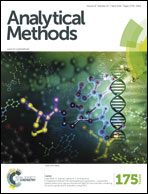Assessment of organosilane-functionalized nano-carbon black for interference-free on-line Pb(ii) ion enrichment in water, herbal medicines and environmental samples
Abstract
In the present work, commercial nano-carbon black (CB) particles were functionalized with 3-mercaptopropyltrimethoxysilane (3-MPTMS) through a silanization reaction to improve their adsorption capacity towards Pb(II) ions and hence extend their application as an alternative and low-cost nanocarbonaceous material in the field of separation science. The material was characterized by FT-IR, scanning electron microscopy (SEM), energy dispersive spectroscopy (EDS), Raman spectroscopy, as well as by thermogravimetric analysis and textural data. After the characterization of the material (3-MPTMS/CB) a FIA-FAAS preconcentration method for Pb(II) ions was developed, which in turn was performed by loading 20.0 mL of a 200 μg L−1 Pb(II) solution at pH 4.76 (buffered with 0.0358 mol L−1 acetate buffer) through 100 mg of 3-MPTMS/CB packed into a mini-column at a flow rate of 4.0 mL min−1. The optimized conditions of the proposed method have been achieved through a 25-1 fractional factorial and Doehlert matrix design. The improvements in the adsorption capacity of CB towards Pb(II) after chemical modification with 3-MPTMS were noticed by comparing the sensitivity of the analytical curve built with CB and 3-MPTMS/CB. Very satisfactory figures of merit including a limit of detection (LOD) of 1.33 μg L−1, limit of quantification (LOQ) of 4.45 μg L−1, preconcentration factor of 28.0, consumptive index of 0.714 mL, preconcentration efficiency of 5.6 min−1 and sample throughput of 12 h−1 were obtained. The precision of the method was assessed as relative standard deviation (RSD) (%) for 10 measures of 10.0 and 160.0 μg L−1 Pb(II) solutions yielding values of 3.0 and 2.3%, respectively. The preconcentration method was successfully applied to the Pb(II) ion determination in different kinds of water and Ginkgo biloba samples with satisfactory recovery values (91–108%). In addition, the accuracy of the proposed method was also checked by analysis of a certified marine sediment reference material (MESS-3).


 Please wait while we load your content...
Please wait while we load your content...